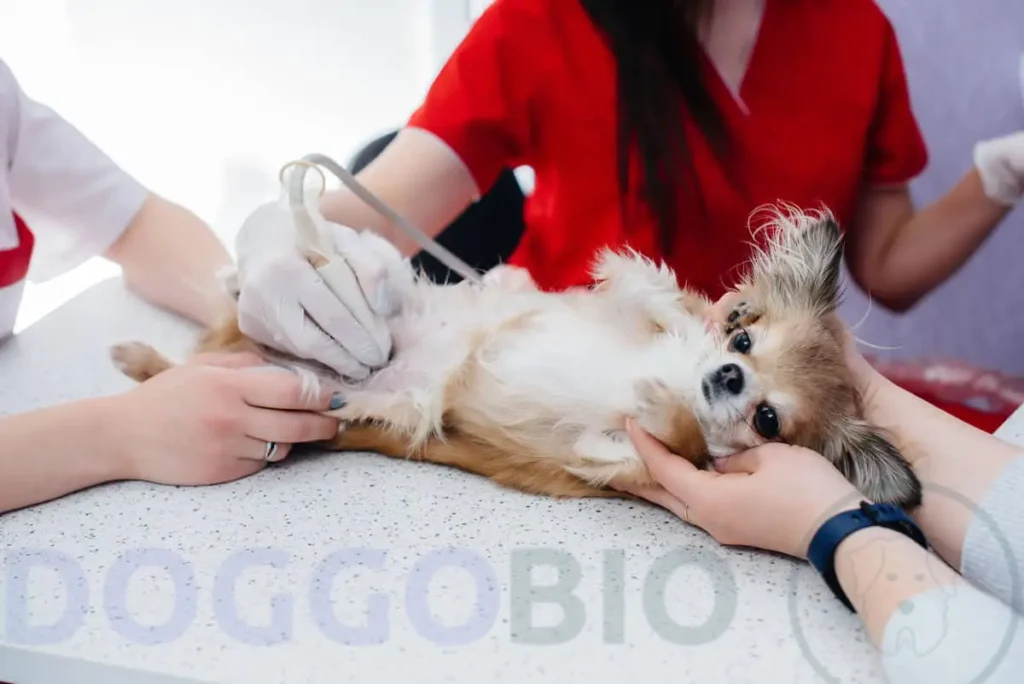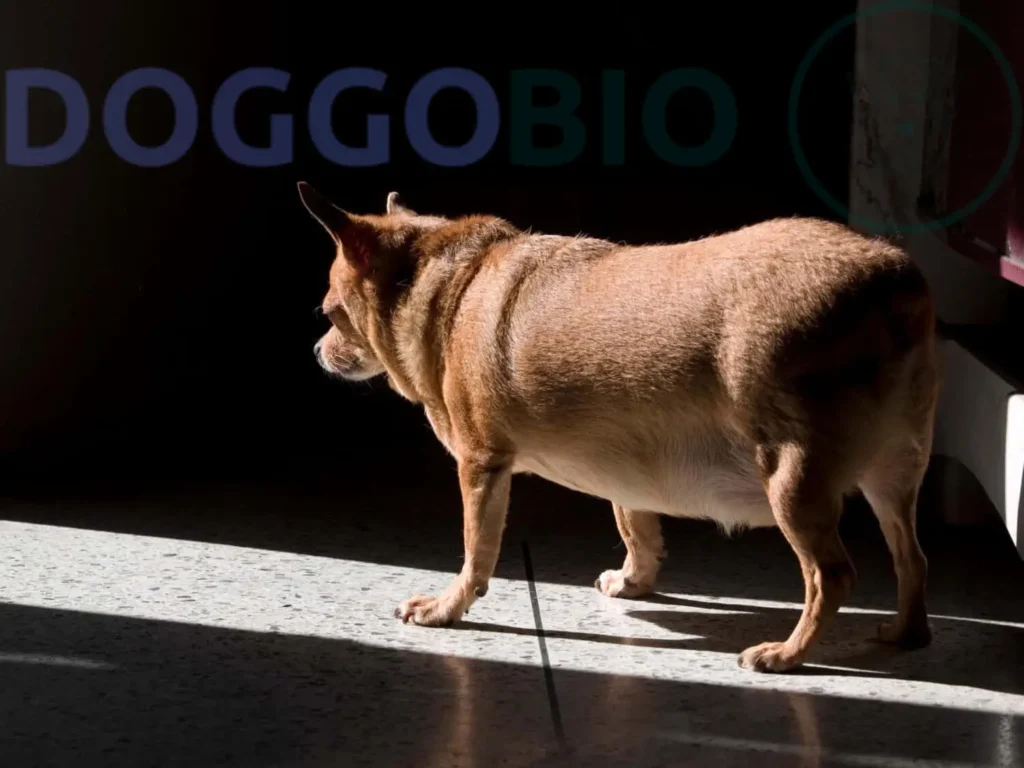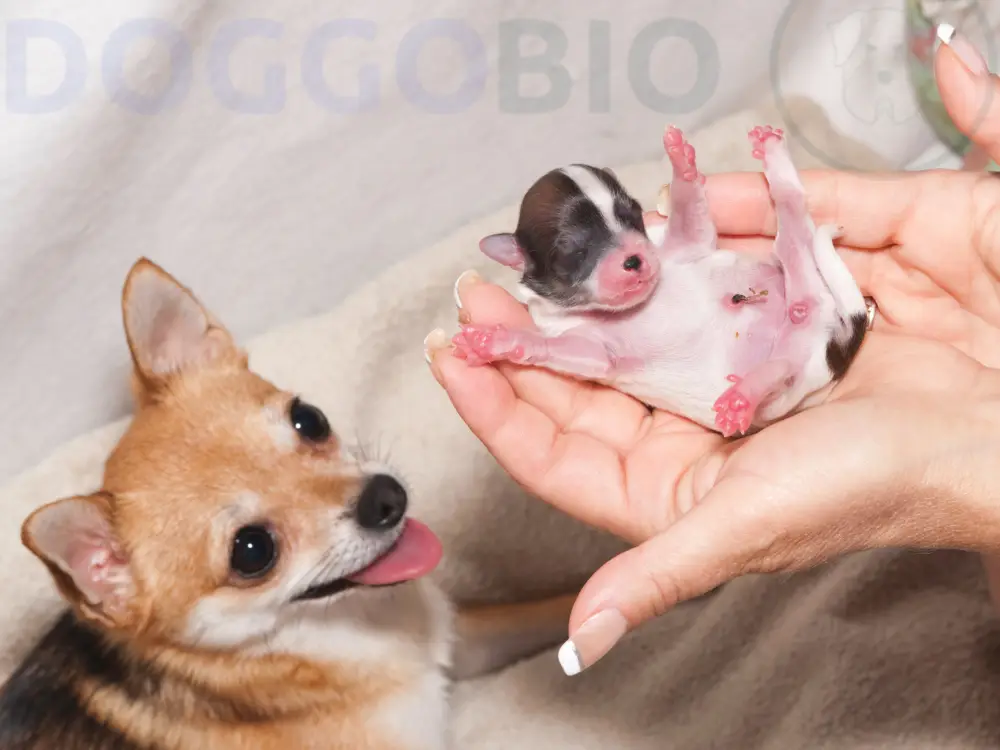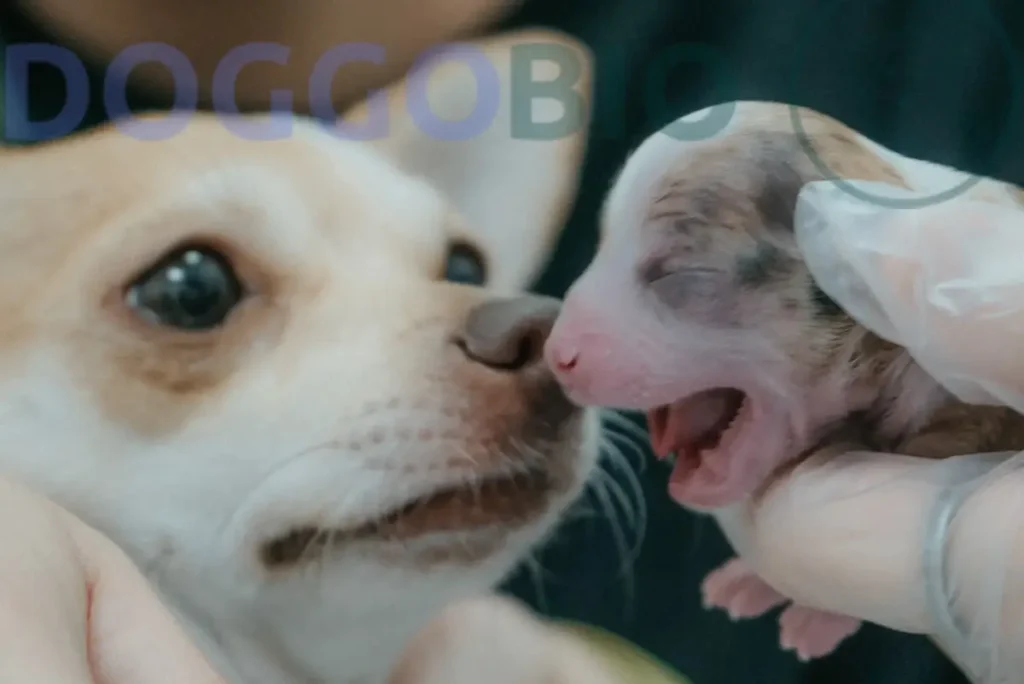The Chihuahua, a tiny toy breed known for its vibrant spirit and charming demeanor, becomes an even more fascinating subject when expecting puppies,especially considering the aspects of dog health.
As with all dogs, pregnancy in Chihuahuas is a delicate phase that requires special attention and care. Due to their petite size, pregnant Chihuahuas face unique challenges and risks, making it essential for owners to be well-informed and prepared.
This guide delves into the world of pregnant Chihuahuas, exploring the signs of pregnancy, prenatal care, potential complications, and the joyous journey to welcoming a litter of adorable Chihuahua puppies.
Whether you’re a seasoned breeder or a concerned pet owner, understanding the nuances of a pregnant Chihuahua will ensure a safer and smoother experience for both the mother and her offspring.
How To Tell If My Chihuahua Is Pregnant?
In the world of canine care, several diagnostic methods can help determine if your Chihuahua is expecting. These methods are not just about confirming pregnancy but also about ensuring the health of the mother and the litter.

1.Blood Test
A blood test is a standard procedure in many veterinary clinics. Around 3-4 weeks post-breeding, a hormone called relaxin becomes detectable. This hormone is a clear indicator of pregnancy and can provide conclusive results.
Regular vet visits and timely blood tests can ensure you’re well-prepared for the upcoming litter. It’s a non-invasive method that gives accurate results, making it a preferred choice for many.
2.Ultrasound
An ultrasound, often seen in human pregnancies, is equally effective for dogs. It’s a non-invasive procedure that provides visual confirmation of the pregnancy.
By the fourth week, the tiny heartbeats of the puppies can be detected. This method not only confirms pregnancy but also gives an insight into the number of puppies and their health.
It’s a magical moment for many pet owners to see those tiny heartbeats for the first time. The experience of seeing the little ones, even if it’s just a blurry image, is a moment of pure joy.
Signs of Pregnancy

1.Behavioral Changes
Just like humans, dogs too undergo behavioral changes when pregnant. Behavioral shifts are often the first signs that pet owners notice.
Your Chihuahua might display mood swings, varying from being overly affectionate to being withdrawn. Such changes, while subtle, are indicative of the hormonal shifts happening within. She might also start nesting, which involves finding a quiet and comfortable spot in anticipation of the upcoming litter.
These behavioral changes are a testament to the profound impact of pregnancy on a Chihuahua’s psyche.
2.Physical Changes
As the weeks progress, the physical changes become more evident.
- There’s a noticeable weight gain, especially around the abdominal area.
- The nipples become more prominent, preparing for the nursing phase.
- An increase in appetite is also a clear sign, as the body demands more nutrition for the growing puppies.
These physical signs are nature’s way of ensuring that the mother is well-prepared for the challenges ahead. The transformation, while gradual, is a sight to behold, as the Chihuahua’s body prepares to nurture new life.
How Long Is A Chihuahua Pregnant?
A Chihuahua is pregnant for an average of 63 days. The gestation period, or the duration of pregnancy, is essential in the life of a Chihuahua, marked by rapid developmental changes.
During this relatively short phase, the mother undergoes significant transformations to nurture the growing puppies. It’s crucial to note the breeding date and keep a close watch on your pet as the expected delivery date nears.
During this time, the tiny embryos mature into fully-formed puppies. Awaiting the puppies’ arrival fills this period with joy and anticipation.
Pregnant Chihuahua Stages
The journey of life, from a single cell to a fully-formed organism, is nothing short of a miracle. Every week of a Chihuahua’s pregnancy brings about new milestones. Awareness of these stages ensures the mother receives the right care at the right time. The transformation from a fertilized egg to a fully-formed puppy is a testament to the miracle of life.

Week 1
The first week is all about beginnings. The journey begins with fertilization. The fertilized eggs make their way to the uterus, marking the start of an incredible journey of life.
It’s a quiet week, with not many external changes, but internally, the stage is set for the development of new life. The promise of new life brings with it hope and joy.
Week 2
As the embryos continue their journey, they find a spot in the uterus and embed themselves in its lining. The uterus, rich in nutrients, ensures that the embryos receive everything they need for growth.
This stage is crucial as it ensures that the embryos receive the necessary nutrients for growth. The anticipation of what’s to come makes this week a time of hope.
Week 3
By the third week, the magic of life is in full swing. The embryos begin to take a more defined shape, transitioning into fetuses. Vital organs start forming, laying the foundation for healthy puppies.
It’s a week of rapid changes, setting the stage for the weeks ahead. The promise of new life becomes more real with each passing day.
Week 4
The fourth week brings with it more visible changes. The mother’s appetite increases and some might even experience morning sickness, much like humans.
An ultrasound at this stage can provide the first glimpse of the puppies, a moment of joy for many pet owners.
Week 5
By the fifth week, the growth of the puppies is now clearly visible through an ultrasound. Their heartbeats can be detected, bringing joy to expectant pet owners.
It’s a week of significant milestones, as the puppies now resemble mini dogs. The anticipation of their arrival makes this week a time of excitement.
Week 6
As the sixth week rolls in, the mother’s abdomen expands, accommodating the rapidly growing puppies. It’s essential to ensure she’s comfortable and well-fed. The puppies, now well-formed, start becoming more active, and their movements might be felt by the mother.
Week 7
The seventh week is all about growth and development. The puppies continue to grow, developing fur and more defined features. Their skeletal system starts to solidify, preparing them for the world outside.
Week 8
The eighth week is a time of preparation. The mother starts nesting, looking for a quiet and comfortable spot for delivery. The puppies are now fully-formed, ready to take on the world. It’s a week of anticipation, as the delivery date draws near.
Week 9
The final week is all about waiting. The mother, now visibly pregnant, becomes more restless. The puppies, fully developed, are ready for birth. It’s a week of excitement and anticipation as the world awaits the arrival of the new puppies.
How Often Do Chihuahuas Go Into Heat?
On average, Chihuahuas go into heat every six months. However, this can vary, with some going into heat more frequently.
It’s essential to be aware of the signs of heat, ensuring that the Chihuahua receives the care and attention she needs. The heat cycle, while a natural process, requires careful monitoring to avoid unwanted pregnancies. Being well-informed and vigilant can ensure that your Chihuahua goes through her heat cycle smoothly.
Reproductive Cycle
The world of canine reproduction is as fascinating as it is complex. The reproductive cycle of Chihuahuas is divided into four stages, each with its unique characteristics.
Understanding these stages can provide insights into the reproductive journey of your Chihuahua. It’s a cycle of life, marked by periods of activity and rest.

1.Proestrus:
The onset of the heat cycle, lasting about 9 days, is marked by a bloody discharge. During this phase, the female is not receptive to males. It’s a time of preparation, setting the stage for the next phase. The body undergoes several changes, in preparing for the possibility of pregnancy.
2.Oestrus:
The Oestrus phase, lasting around 9 days, is when the magic happens. This is the fertile phase. The female is receptive, and mating can lead to pregnancy. It’s a time of hope and anticipation, as the possibility of new life looms on the horizon. The body is now primed for conception, awaiting the perfect moment.
3.Diestrus:
The Diestrus phase is a period of reflection. Depending on whether the female has conceived, this phase either marks the beginning of pregnancy or prepares the body for the next cycle. It’s a time of change, as the body either gears up for pregnancy or starts the recovery process.
4.Anestrus
The Anestrus phase is all about rest and recovery. A resting phase, allowing the female’s body to recover and prepare for the next heat cycle. It’s a time of calm, as the body rejuvenates and gets ready for the challenges ahead. The body, having gone through the challenges of the previous phases, now seeks rest and rejuvenation.
Preparing For A Pregnant Chihuahua
The news of a pregnant Chihuahua can bring mixed emotions. Ensuring the well-being of your pregnant Chihuahua requires careful planning and attention.
Pregnancy, while a natural process, can be taxing on the body. Providing the mother is in peak health is crucial for a smooth pregnancy.
The journey of expecting puppies is filled with joy, anticipation, And sometimes anxiety. Every pet owner dreams of seeing their beloved Chihuahua become a mother, nurturing her little ones.
A. Health Considerations
1. Pre-pregnancy Health Check
Before embarking on the journey of pregnancy, a thorough health check can identify potential issues, ensuring a smooth pregnancy.
It’s like laying the foundation for a building, ensuring everything is in order before the construction begins. The health check provides a roadmap, guiding the pet owner through the various stages of pregnancy.
2. Nutritional Requirements
As the body prepares to nurture new life, its nutritional needs skyrocket. A balanced diet ensures the health of the mother and her puppies. It’s not just about quantity but also quality.
Ensuring that the mother gets all the essential nutrients is crucial for the well-being of the puppies. The body, now nurturing new life, demands more nutrition.
3. Exercise And Activity Modifications
While exercise is essential for the dog’s health, moderation is key during pregnancy.
Strenuous activities should be avoided, and care should be taken to ensure the mother is not stressed. The body, now carrying the added weight of the puppies, requires special care.
B. Creating A Suitable Nesting Area
As the delivery date approaches, the mother will start looking for a quiet and comfortable spot. Providing a suitable nesting area ensures a stress-free environment for the mother. It’s about creating a sanctuary where the mother feels safe and secure.
C. Veterinary Care And Prenatal Check-ups
Regular check-ups are the cornerstone of a healthy pregnancy. They monitor the health of the mother and her puppies and ensure timely interventions if needed. It’s about being proactive, addressing issues before they become problems.
Regular vet visits ensure that the mother is in peak health and ready for the challenges ahead.
Labor and Delivery
As the anticipated delivery time nears, the mother exhibits signs of upcoming labor. Being attuned to these indicators allows pet owners to brace themselves for imminent birth, emphasizing a proactive approach to safeguard the mother and her offspring.
Labor unfolds in three distinct phases, each presenting its set of challenges. Understanding these phases is pivotal for timely and appropriate care, underscoring the marvel of birth.
1. Initiation of Labor:
This phase is characterized by contractions, signaling the body’s readiness for the birthing journey. The atmosphere is thick with expectancy as everyone keenly awaits the puppies’ debut.
2. Active Labor and Birth:
This is the heart of the birthing process. Puppies navigate their way into the world, heralding the start of an exciting new saga. It’s a time of elation and festivity as the puppies are introduced to their new environment.
3. Postpartum Phase:
Following the birth, the mother proceeds to expel the placenta, culminating in the delivery process.
While the act of giving birth is a natural phenomenon, it’s not devoid of challenges. Familiarity with the birthing stages equips pet owners to offer the requisite care and comfort to the mother.
Any indications of discomfort or potential complications necessitate swift veterinary attention, reinforcing the importance of vigilance and proactive care for the well-being of the mother and her puppies.
Caring For Newborn Chihuahua Puppies
The first few hours after birth are pivotal. Monitoring each puppy’s breathing and activity is essential to set the stage for robust health.
The bond formed between the mother and her offspring during these initial moments is invaluable. Prioritizing uninterrupted bonding time fortifies this connection. The mother’s milk is the primary source of vital nutrients for the puppies; hence, keeping her nourished and hydrated directly impacts their well-being.
In the early weeks, consistent veterinary check-ups are vital to ensuring the puppies’ optimal growth and health.
Responsible Breeding Practices
Prioritizing the health and welfare of the dog is paramount in breeding. It’s vital to ensure both males and females are in optimal health, devoid of genetic issues, and possess stable temperaments.
Overbreeding a Chihuahua without sufficient recovery periods can result in health issues. Full recovery between pregnancies is imperative.
Before breeding, ascertain a genuine demand for the puppies and that they will be placed in caring and responsible households.
How Chihuahuas Differ From Other Breeds During Pregnancy?
Chihuahuas, due to their diminutive stature, present unique challenges during pregnancy compared to other species.
Their compact size can pose difficulties in carrying more giant puppies, increasing the likelihood of requiring C-sections.
Additionally, Chihuahuas are more prone to specific health issues during gestation, such as eclampsia, characterized by a rapid decrease in blood calcium levels. Frequent veterinary visits and a nutritious diet are essential to ensure their well-being.
Do Chihuahuas Need To Give Birth Via C-sections?
Chihuahuas, with their petite size, often raise concerns regarding birthing complications. The possibility of a C-section, while not always necessary, is higher in Chihuahuas compared to larger breeds.
The decision to opt for a C-section is often based on the health of the mother and the size of the puppies. Regular vet consultations and timely interventions can ensure a smooth delivery. The well-being of the mother and her puppies is paramount, and sometimes, a C-section is the best option.
It’s essential to be prepared for any eventuality, ensuring the safety of both the mother and her puppies.
Frequently Asked Questions
How Many Puppies Can A Chihuahua Have At First Time?
On average, Chihuahuas give birth to 2-5 puppies. However, this can vary based on several factors, including age, health, and genetics.
Are There Risks For Chihuahuas Giving Birth?
Due to their small size, Chihuahuas can face complications during pregnancy and delivery. Regular vet consultations and timely interventions can ensure a smooth delivery.
Can Chihuahuas Deliver Without Assistance?
While many Chihuahuas can give without help, it’s essential to monitor for signs of distress and be prepared for any eventuality.
What Happens If Chihuahua Is Pregnant By A Large Dog?
Mating a Chihuahua with a giant breed can lead to complications during pregnancy and delivery. It’s essential to ensure that the male is similar in size to avoid complications.
Can An 8-year-old Chihuahua Get Pregnant Naturally?
While an 8-year-old Chihuahua can get pregnant, it’s advisable to prevent breeding older dogs due to potential health risks.
How to Help Your Chihuahua During Labor?
Ensure she’s comfortable, provide a quiet and calm environment, and monitor for signs of distress. Be prepared to seek veterinary assistance if needed.
What is the ideal size of a chihuahua?
A healthy size for a Chihuahua typically ranges from 1.13 to 2.04 kg (2.5-4.5 lbs) according to the Chihuahua Growth Chart. However, individual variations exist, so consulting a vet for guidance specific to your dog is important. Regular monitoring of weight and adherence to proper diet and exercise help maintain their health.
Conclusion
Navigating the journey of a pregnant Chihuahua can be both a rewarding and challenging experience. Their diminutive size and unique physiological needs demand heightened vigilance and care from their owners. By being well-informed and proactive, one can ensure that these tiny mothers-to-be receive the best possible care, paving the way for a healthy litter of puppies.
As with any aspect of pet ownership, the well-being of a pregnant Chihuahua hinges on love, understanding, and dedication. By embracing these principles, owners can look forward to the unparalleled joy of witnessing the miracle of birth and the arrival of a new generation of delightful Chihuahua pups.
